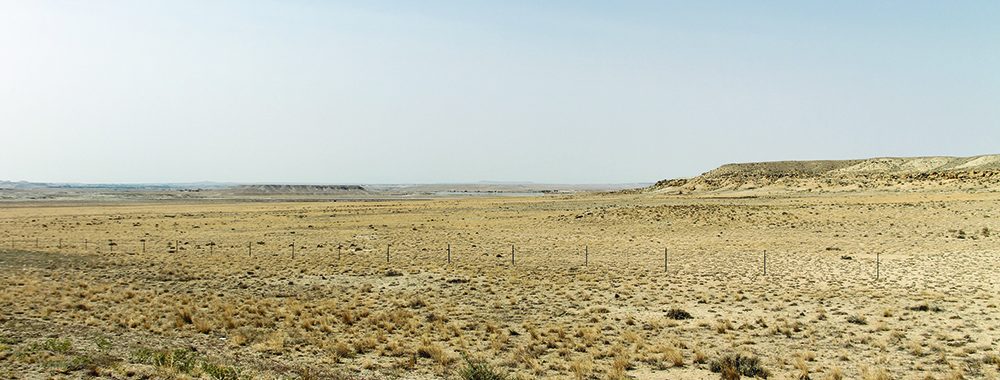Management of rangeland before, during, and after drought is critical.
In desperate times, producers may be tempted to get what they can out of rangeland to preserve herds. Just remember, the drought may last more than one season, and the effects of one or two years of overgrazing can lead to many more years of soil erosion, decreased plant production, and weed infestations after the drought.
Shock to a Plant’s System
Drought influences plants at the cellular level, affecting all biochemical and physiological processes used to make food and survive. The plant may not expend valuable resources for reproduction, so seed heads do not develop. In extreme cases, there are a reduced number of plant basal buds, which results in fewer shoots produced the following year. The plant will eventually die if this occurs over a period of years.
Plants have above and below ground components – shoots and roots. They must be able to support both through photosynthesis, transpiration, and respiration. During drought, a robust root system is important for the plant to extract what little soil moisture is present. When soil moisture is limited, shoot growth is reduced and plants have a harder time making their own food. There is less energy to support healthy, growing roots and shoots.
Grazing Effects on Plant Growth, Soil Moisture
Understanding how livestock grazing affects plant growth and soil moisture is key to making proper management decisions. Rangeland that has a diversity of plant species, optimum plant cover, and plants with robust root systems, has greater infiltration of moisture into the soil compared to rangeland that has been overgrazed or is in poor condition.
Rangeland in poor condition typically has less plant cover, more soil compaction, and less productive plant species. This can intensify drought effects like runoff and decreased soil moisture. Leaving standing forage and plant litter on the soil surface lessens these effects.
Proper grazing can increase and maintain plant health, while improper and overgrazing can lead to a decline in plant health. Most grazing livestock select the tastiest plants first. If livestock are in a pasture for long periods, they will graze the same desirable plants repeatedly, not allowing for plant recovery between grazing. They will also select grasses and forbs in the vegetative stage first.
Grasses grazed during the elongation phase (when plants start to send up seed heads) typically produce less forage in subsequent years. Grazing in one pasture for long time periods or grazing during the elongation phase year after year can lead to decreased forage production, less desirable plant species, and increased bare ground.
How Much to Graze?
Determining what constitutes an appropriate level of grazing for drought conditions is an art and a science. Research has shown how certain plants respond to drought and grazing pressure, but each management scenario and suite of species presents a unique challenge.
Range managers typically refer to standards of how much forage can be removed by dry weight while maintaining landscape health and plant resilience. These can be adjusted depending on things like drought conditions, period of rest, and results of monitoring. Understanding the capabilities of your soil to produce certain forage grasses and implementing a monitoring plan is a good place to start.
If rangelands are grazed during drought, managers must be careful to consider both above and below ground plant health. Stocking rates should be adjusted accordingly to ensure plants are not overgrazed, and enough residual plant material is left to maintain photosynthesis, root health, and soil cover.
Even if stocking rates are reduced, rotating livestock during grazing so plants are allowed time to recover is important. In addition, allowing grazing when plants are least susceptible to defoliation, prior to stem elongation or late in the season after plants have gone dormant, is an option that can help reduce the detrimental grazing effects during drought.
Grazing 50 Percent
A plant community can overcome drought if good grazing management is practiced by not allowing livestock to remove too much plant material; no more than 50 percent of aboveground growth. However, if overgrazing occurs and plants are weakened through excessive loss of leaves, weedy species can benefit from the reduction in these desirable plants and even increase during drought conditions.
The severity and timing of the drought will determine what type of grazing, if any, can occur on a particular rangeland.
If drought is severe, plant growth is greatly limited, leaving little useable grazable forage. Completely removing livestock from the rangeland may be warranted.
If drought occurs early in the growing season but is not severe, plant growth may be adequate for some controlled grazing.
If drought occurs late in the growing season, grazing plants may not be affected, but soil moisture and subsequent growing season moisture and plant growth should be monitored.
Production and management strategies to maintain plant health during a drought include destocking pastures, early weaning of young livestock, stockpiling forage, purchasing harvested feeds, and leasing pastures elsewhere.
Which plan you choose will greatly depend on the type of operation, drought severity, previous management, and rangeland health.
More information on drought planning and management strategies is available by going to www.uwyo.edu/uwe and clicking on Publications, then typing in “Drought” in the search field or by speaking with your local University of Wyoming Extension educator.
Extension educators Glenn Owings based in Sublette County can be reached at (307) 367-4380 or at gowings@uwyo.edu, and Blaine Horn based in Johnson County at (307) 684-7522 or bhorn@uwyo.edu. Extension invasive plant specialist Dan Tekiela is an assistant professor in the Department of Plant Sciences can be contacted at (307) 766-3113 or dtekiela@uwyo.edu.





